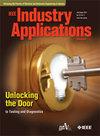Development of Solid Synchronous Reluctance Rotors With Multi-Material Additive Manufacturing
IF 4.2
2区 工程技术
Q2 ENGINEERING, ELECTRICAL & ELECTRONIC
引用次数: 0
Abstract
Synchronous reluctance (SynR) machines are promising rare-earth material-free alternatives to permanent magnet machines. However, structural challenges limit their operating speed and power density. This paper proposes and investigates multi-material additive manufacturing (MMAM) as a key-enabler to realize power-dense and high-speed SynR machines. It does so by proposing designs that guide magnetic flux through solid rotors realized by selective placement of magnetic and non-magnetic materials. To explore this concept, first, material samples are additively manufactured and experimentally characterized to assess the structural and magnetic properties that can be expected for the proposed rotors. Second, the design space of each rotor type is explored using these measured properties within finite element analysis. The results reveal that MMAM can enable fabrication of SynR motors with power density levels that are at the leading edge of all conventional electric machine topologies. It is shown that tip speeds in excess of 300 m/s can be achieved, resulting in 3-4x improvement in power density over conventional SynR motors. A solid SynR rotor is printed in an experimental MMAM laser powder bed fusion system. The rotor is paired with an existing stator to create a functional SynR motor with a saliency ratio of 2.59 and torque rating of 4.15 Nm. This is the first publication of a SynR rotor prototype constructed via MMAM.求助全文
约1分钟内获得全文
求助全文
来源期刊

IEEE Transactions on Industry Applications
工程技术-工程:电子与电气
CiteScore
9.90
自引率
9.10%
发文量
747
审稿时长
3.3 months
期刊介绍:
The scope of the IEEE Transactions on Industry Applications includes all scope items of the IEEE Industry Applications Society, that is, the advancement of the theory and practice of electrical and electronic engineering in the development, design, manufacture, and application of electrical systems, apparatus, devices, and controls to the processes and equipment of industry and commerce; the promotion of safe, reliable, and economic installations; industry leadership in energy conservation and environmental, health, and safety issues; the creation of voluntary engineering standards and recommended practices; and the professional development of its membership.
 求助内容:
求助内容: 应助结果提醒方式:
应助结果提醒方式:


